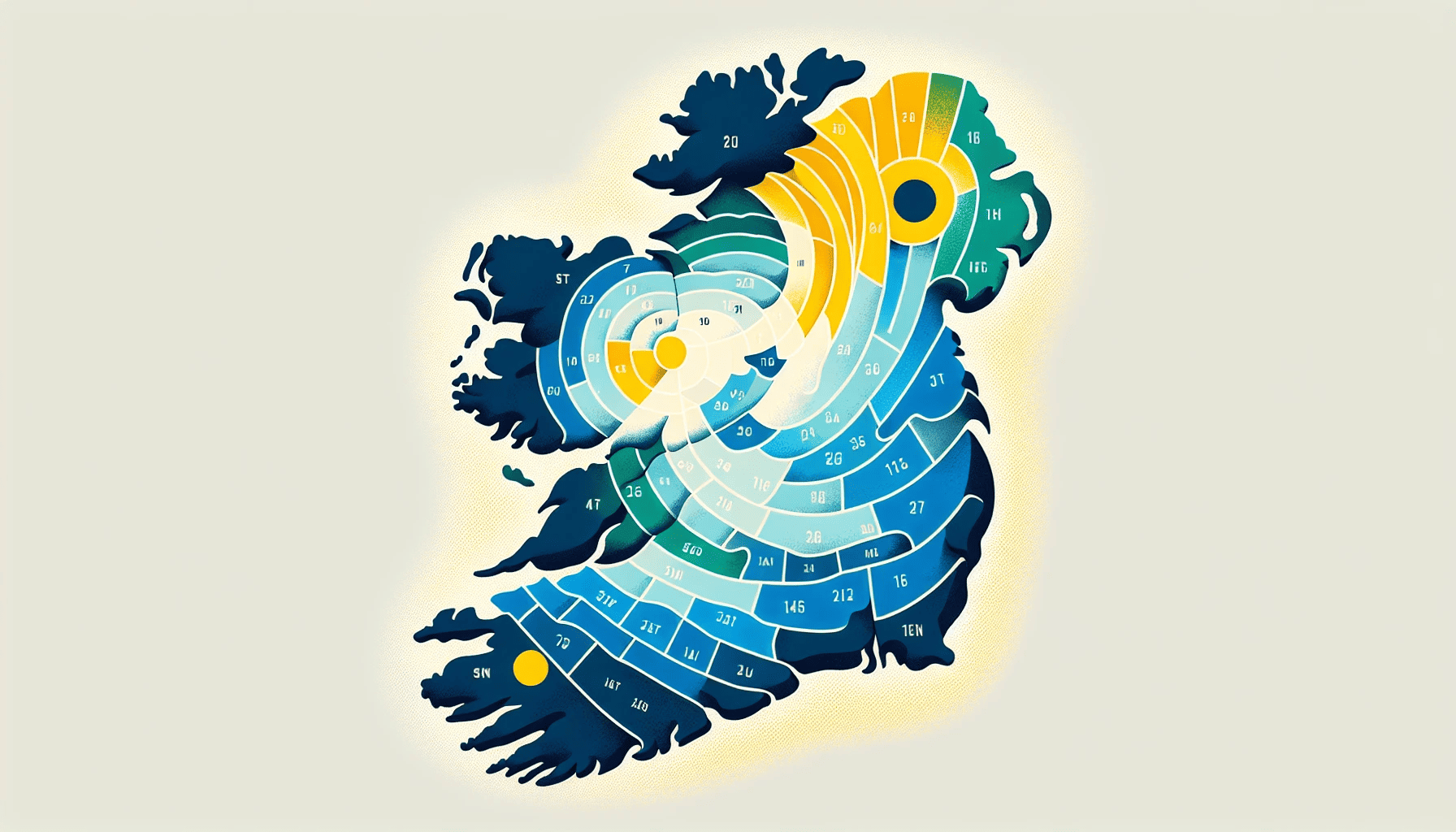Ireland, the land of leprechauns and pots of gold, is also a country with a truly captivating climate. Often described as having four seasons in one day, the Emerald Isle’s weather keeps visitors on their toes. If you’re planning a trip to this enchanting destination, understanding the nuances of Ireland’s weather by month, “Ireland weather by month,” will help you pack and plan accordingly for a memorable experience.
Key Takeaways
- Ireland has a mild climate with frequent rainfall and changeable weather due to its oceanic influence.
- The month-by-month breakdown of Ireland’s climate provides an essential guide for planning a successful journey.
- Planning ahead with season specific tips is essential for having an enjoyable visit to Ireland regardless of the time of year.
Overview of Ireland’s Climate

Ireland’s weather is characterized by mild temperatures, frequent rainfall, and changeable conditions due to its oceanic influence. The country enjoys generally warm summers with average daily temperatures ranging from 12.3 °C (54.1 °F) to 15.7 °C (60.3 °F), avoiding temperature extremes. Mean daily temperatures during summer often hover around 15°C / 59°F during milder periods. Winters are mild, with average daily temperatures between 4.0 °C (39.2 °F) and 7.6 °C (45.7 °F).
Rainfall is abundant and well-distributed throughout the year, with December and January being the wettest months. The average daily sunshine hours during the months of May and June is between 5 to 6.5 hours. These are some of the sunniest months, and their months sunshine duration averages are among the highest.
Oceanic Influence
The Gulf Stream, a warm ocean current flowing from the Gulf of Mexico, has a substantial impact on Ireland’s climate. This mighty oceanic force results in mild winters and cool summers by transporting warm waters up through the Atlantic Ocean. The sea temperature brought by the Gulf Stream plays a significant role in maintaining the temperate climate that Ireland is known for. The Atlantic influence also brings frequent and sometimes strong wind, especially along the coasts.
However, recent reports suggest that the Gulf Stream could diminish, potentially leading to lower temperatures in the future.
Rainfall Patterns
Rainfall in Ireland is nothing short of abundant, with December and January taking the crown as the wettest months. The average annual precipitation in Ireland is approximately 1230 mm. This plentitude of rainfall is a direct result of the Gulf Stream and the country’s mild, humid, and changeable climate.
In Ireland, there is a variance in rainfall distribution across different regions. The western half of the country and high ground experience the highest amount of rainfall, while rainfall decreases as one moves towards the northeast. Mountainous districts can receive in excess of 2000mm of rainfall per annum. Generally, the west is more humid than the east. Compared to previous months, rainfall in the winter is significantly higher, highlighting the seasonal trends typical of Ireland’s climate.
Climate Data and Statistics
When planning to visit Ireland, understanding the climate data and weather statistics can help you make the most of your trip to the Emerald Isle. Ireland’s climate is classified as temperate oceanic, shaped by its position in Western Europe and the moderating influence of the Atlantic Ocean and the Gulf Stream. This results in mild temperatures year round, with average daily temperatures ranging from 5°C (41°F) in January and February to 16°C (61°F) in July and August.
The west coast of Ireland, including areas like County Donegal and the western highlands, tends to be milder and wetter than the east coast, thanks to the Atlantic’s warming effect. In contrast, the east coast, including Dublin, generally experiences less rainfall and slightly cooler winters. The southeast coast is often the driest part of the country, with average annual rainfall of less than 760 mm (30 inches), making it a popular spot for those seeking more sunny days.
Rainfall is a defining feature of the climate of Ireland, with average annual rainfall across the country around 1,000 mm (39 inches). However, this varies significantly by region: the west coast and mountainous regions such as the Wicklow Mountains can receive over 1,200 mm (47 inches) per year, while inland areas and the east coast are typically drier. The wettest months are from October to December, while April to June are usually the driest, offering more opportunities for outdoor activities.
Sunshine is another important aspect of Ireland’s weather. The sunniest months are May and June, with an average of 6-7 hours of sunshine per day, making late spring and early summer an excellent time to visit Ireland. July and August bring the warmest weather, with average high temperatures between 18°C (64°F) and 20°C (68°F), perfect for exploring the country’s rolling hills, dramatic coastlines, and vibrant cities.
While Ireland is not prone to extreme weather events like hurricanes or tornadoes, severe weather can occur, especially during the winter months. Strong winds and Atlantic storms are most common from October to February, particularly along the west coast. Snow is rare but possible, especially in the mountainous regions.
According to Met Éireann, the Irish Meteorological Service, the average temperature across the country is about 10°C (50°F), and Ireland enjoys approximately 1,500 hours of sunshine per year. The climate of Ireland is mild and inviting, making it a year-round destination. Whether you’re seeking the warmest weather in the summer months, the atmospheric charm of the wettest months, or the long daylight hours of late spring, there’s always a good time to visit Ireland.
By considering Ireland’s climate data and statistics, you can plan your trip to match your preferences—whether you want to experience the lush green landscapes after a rain, the mild winters of the southwest coast, or the sunniest days along the southeast coast. No matter when you choose to visit, Ireland’s weather is just one part of the country’s enduring appeal, offering a unique experience in every season.
Month-by-Month Weather Breakdown

We provide a detailed month-by-month weather breakdown to support the planning of your Irish journey. From the chill of January to the warmth of July, each month offers its unique charms and challenges. Understanding the nuances of Ireland’s climate will allow you to pack appropriately and make the most of your visit to this enchanting land. You can expect Ireland’s weather to be highly variable and unpredictable, with each month bringing different patterns of rainfall, sunshine, and temperature.
January
Ireland experiences its coldest month in January, with temperatures varying between 3°C-7°C. Frequent rain, ice, and snow are common during this period, blanketing the landscape in a serene white layer. While the chill may deter some, January offers a unique opportunity to experience the country’s breathtaking beauty in a serene, wintery setting.
January is also part of the ‘J F M’ period (January, February, March), which typically represents the coldest and wettest part of the year in climate data.
February
February continues to be cold and wet during the winter months, albeit with a little less rainfall than January. Here are some key weather statistics for the month, including the average temperature and average temperatures range:
- Temperatures typically range from 3°C-7°C
- Precipitation averages 87.8 millimeters
- Despite the chilly conditions, the occasional spell of higher temperatures reaching up to 16°C (60°F) can make for a pleasant surprise.
March
Ireland welcomes the arrival of spring in March, characterized by temperatures between 4°C-10°C and rainfall up to 70mm. As the days grow longer and nature begins to awaken, the Emerald Isle’s landscapes transform into a vibrant tapestry of colors, making it a perfect time for outdoor exploration.
April
April, one of Ireland’s driest months, enjoys milder temperatures of 5°C-11°C and a decrease in rainfall. With the landscape in full bloom, it’s an ideal time to embark on scenic hikes, bike rides, and other outdoor activities that allow you to soak in the picturesque beauty of Ireland’s countryside.
May
May presents agreeable weather for outdoor pursuits, characterized by temperatures between 7°C-15°C and minimal rainfall. As the sunniest month in Ireland, May is an excellent time to explore the country’s charming towns, rugged coastlines, and lush landscapes, all bathed in the warm glow of the sun.
June
The summer season commences in Ireland in June, marked by cooler temperatures and an average rainfall of 70mm. Despite the cooler weather, June offers an abundance of daylight hours, making it a prime time to explore the country’s rich history, vibrant culture, and stunning natural beauty.
July

July and August, with their warm temperatures of 12°C-19°C, low rainfall, and extended daylight hours, are ideal for outdoor pursuits. Whether you’re basking in the sun on a sandy beach or exploring ancient castles, these months offer an abundance of opportunities to create unforgettable memories in Ireland.
August
August, characterized by temperatures between 12°C-19°C and increased rainfall, may also experience storms. While the weather can be unpredictable, the beauty of Ireland’s landscapes and the warmth of its people make August a delightful time to visit.
September
September graces Ireland with picturesque autumnal scenery, featuring temperatures between 10°C-17°C and approximately 60mm of rainfall. As the leaves change color and the days grow shorter, the Irish countryside takes on a whole new level of beauty, perfect for leisurely strolls and cozy evenings by the fire.
October
October, characterized by mild temperatures of 8°C-13°C and increased rainfall, sees shorter days due to the conclusion of Daylight Savings. As the weather turns cooler and more unpredictable, it’s a perfect time to explore Ireland’s vibrant cities, charming towns, and cozy pubs.
November
November in Ireland:
- Cooler temperatures of 5°C-10°C
- 60mm of rainfall
- Potential for record highs
- Unique opportunity to experience Ireland’s natural beauty as it transitions from the vibrant colors of autumn to the stark beauty of winter.
December
December brings cold and rainy conditions to Ireland, with temperatures from 5°C to 8°C and occasional snowflakes around Christmas. While the weather may not be as inviting as in other months, Ireland’s festive spirit and twinkling lights make it a magical time to visit.
Regional Weather Variations
The diversity of Ireland’s landscape presents a variety of regional weather variations, lending uniqueness to each area’s climate. County Kerry, particularly around Valentia Island, is known for its distinctive weather patterns and relatively mild conditions compared to other regions. Malin Head, the northernmost point in Ireland, is notable for its unique climate conditions, including cooler temperatures and higher wind speeds.
From the mild winters of the Southwest Coast to the sunnier Southeast Coast, understanding these variations—including the S O climate characteristics that influence seasonal changes—will help you tailor your Irish adventure to your personal preferences and the time of year you plan to visit.
East Coast
The East Coast, including Dublin, experiences relatively warm summers, less rain, and frequent cloudy skies. Despite this, the region still offers plenty of opportunities for outdoor exploration and cultural experiences, making it a popular destination for travelers.
West Coast
The West Coast is known for its:
- Wild weather, with milder winters and wetter conditions overall
- Rugged and untamed landscape
- Perfect for those seeking adventure and an escape from the hustle and bustle of city life.
Southeast Coast

The Southeast Coast, also known as the “Sunny South-East,” has the best weather in Ireland, with more sunshine and less rainfall. This region boasts some of the country’s most beautiful beaches, charming coastal towns, and an abundance of outdoor activities to enjoy in the warmer weather.
Southwest Coast
The Southwest Coast, including Valentia Island, has mild winters and abundant rainfall, with a unique sub-tropical climate. This region is home to some of Ireland’s most stunning landscapes, including the famous Ring of Kerry and the Dingle Peninsula, making it a must-visit destination for nature enthusiasts.
Tips for Visiting Ireland by Season
Regardless of the season in which you visit Ireland, understanding the expected weather and packing suitably will contribute to having an optimal experience. From waterproof shoes to breathable layers, we’ve got you covered with our season-specific tips for your Irish adventure.
Spring
Spring in Ireland is cool and unpredictable, with frequent rain. Pack breathable clothes, waterproof outerwear, and sensible footwear to ensure you’re prepared for whatever the weather may bring.
As the days grow longer and the landscape comes alive, spring is the perfect time to explore Ireland’s natural beauty.
Summer

Summer in Ireland offers lush landscapes and sunny days. Pack for moderate weather, including light layers and waterproof shoes, as sudden rain showers are not uncommon.
Don’t forget sunscreen and sunglasses, as the sun can be quite strong on clear days, especially during sun rising.
Autumn
Autumn weather in Ireland is often cloudy and wet. Windy conditions are a common occurence during this season. Pack rain gear, including a waterproof coat and sturdy shoes, as well as warm clothes for cooler days.
Autumn is the perfect time to take in the stunning fall foliage and enjoy cozy evenings by the fire in one of Ireland’s many traditional pubs.
Winter
Winter in Ireland is chilly, with frequent rain and occasional higher temperatures – a typical example of Irish weather. Be sure to pack warm clothes, including heavy sweaters, a warm coat, and winter accessories, as well as waterproof shoes to keep your feet dry and comfortable.
While snow is rare, it’s always best to be prepared for any weather during your visit.
Summary
From the mild winters of the Southwest Coast to the sunnier Southeast Coast, Ireland’s climate offers something for everyone. Whether you’re visiting during the cool and unpredictable spring, the lush and sunny summer, the cloudy and wet autumn, or the chilly and rainy winter, understanding the nuances of Ireland’s weather will help you pack and plan accordingly for a truly unforgettable adventure.
As you prepare for your journey to the Emerald Isle, keep in mind the regional weather variations and seasonal differences, and pack accordingly. With the right preparation and an open mind, you’ll be well on your way to experiencing the magic and beauty of Ireland, no matter the weather.
Frequently Asked Questions
What is the average temperature in Ireland by month?
On average, Ireland’s temperatures range from 5°C in January to 16°C in July.
What is the best month to visit Ireland?
The best time to visit Ireland is during the shoulder season of May, September, and October. During these months, travelers will enjoy mild temperatures, plenty of dry spells, and cheaper accommodation and flight prices, as well as a packed festival calendar with fewer crowds.
What is rainy season in Ireland?
Rainy season in Ireland occurs mainly during the months of February, March, August, September, October, November, December and January, with average rainfall totals of around 100-130 mm.
What is the warmest month in Dublin Ireland?
July is the warmest month in Dublin, Ireland with an average temperature of 16°C (60°F). Maximum temperatures reach 20oC (68oF), while minimum temperatures remain at 11oC (53oF). However, August is the wettest month with 80mm of rain.
Does it snow often in Ireland during winter?
Snowfall in Ireland during winter is relatively rare and unpredictable, with most snowfall occurring between December and March, so it does not snow often.

